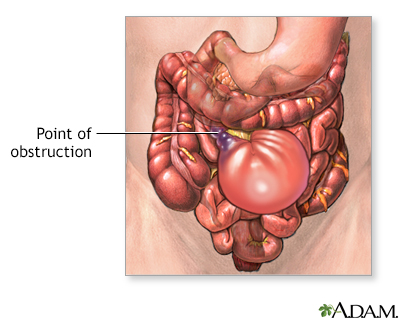Intestinal obstruction repair
Normal anatomy
|
|
The intestine is made up of the small intestine and the large intestine (colon). The small intestine runs from the stomach to the large intestine. The colon runs from the end of the small intestine to the anus. The intestine absorbs nutrients and water from the diet.
|
Indication, part 1
|
|
Obstruction of the intestine occurs when food and water cannot pass through the intestine. The area of intestine nearest to the obstruction becomes dilated and non-functioning. If the obstruction is not relieved, it can lead to intestinal gangrene and perforation.
|
Indication, part 2
|
|
The most common causes of intestinal obstruction in adults are adhesions, hernias, and colon cancer. Adhesions are scars that form between loops of intestine, usually caused by prior surgery, which causes such scar formation. Hernias are areas of weakness in the abdominal wall, through which loops of intestine can slip and become trapped. Colon cancer is one of the most common forms of cancer. While each reason for intestinal obstruction requires a different treatment, all intestinal obstructions are potentially life-threatening.
|
Incision
|
|
In most cases, surgery is necessary. While the patient is deep asleep and pain-free (general anesthesia), an incision is made in the midline of the abdomen. In the case of adhesions, the adhesion is removed, thus relieving the obstruction. In the case of a hernia, the hernia is repaired. If colon cancer is present, cancerous areas are removed, which also relieves the obstruction.
|
Procedure
|
|
In all cases, the intestine involved in the obstruction is examined. If any parts of the intestine look unhealthy from lack of blood flow during the period of obstruction, they are removed and the healthy ends are reconnected. A patient's recovery depends on several factors, including the cause of the intestinal obstruction and the length of time prior to relief of the obstruction.
|

Review Date:2/28/2022
Reviewed By:Debra G. Wechter, MD, FACS, General Surgery Practice Specializing in Breast Cancer, Virginia Mason Medical Center, Seattle, WA. Also reviewed by David Zieve, MD, MHA, Medical Director, Brenda Conaway, Editorial Director, and the A.D.A.M. Editorial team.
The information provided herein should not be used during any medical emergency
or for the diagnosis or treatment of any medical condition. A licensed medical professional
should be consulted for diagnosis and treatment of any and all medical conditions. Call 911
for all medical emergencies. Links to other sites are provided for information only -- they
do not constitute endorsements of those other sites. © 1997-A.D.A.M., Inc. Any duplication or distribution of the information contained herein is strictly prohibited.
The Agency for Health Care Administration (Agency) and this website do not claim the information on, or referred to by, this site is error free. This site may include links to websites of other government agencies or private groups. Our Agency and this website do not control such sites and are not responsible for their content. Reference to or links to any other group, product, service, or information does not mean our Agency or this website approves of that group, product, service, or information.
Additionally, while health information provided through this website may be a valuable resource for the public, it is not designed to offer medical advice. Talk with your doctor about medical care questions you may have.





